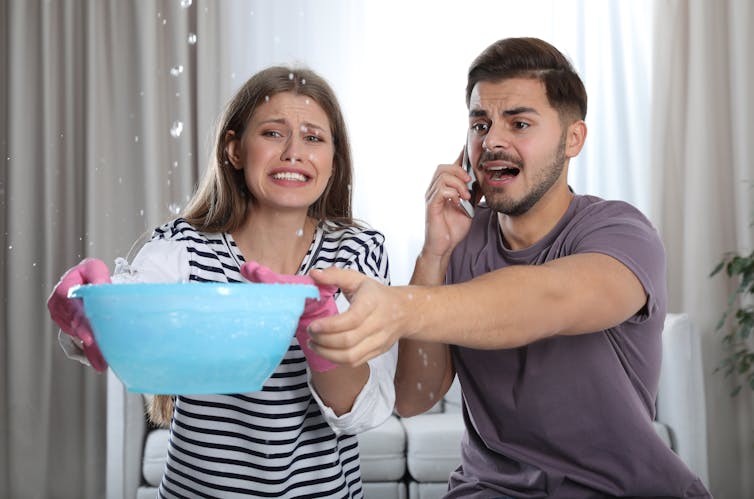Renters In England Can Now Sue Landlords Over Mouldy, Cold or Noisy Properties
Landlord to the rescue? Shutterstock.
Emily Walsh, University of Portsmouth
A new law recently came into force, which gives tenants in England greater powers to hold landlords to account over homes which are difficult or dangerous to live in. Before these changes, landlords had only limited obligations to keep properties in good repair during tenancies, and as a result it’s estimated that almost 1m rented homes pose a serious risk to health and safety.
The law means that landlords leasing out properties for less than seven years must ensure the place is fit for people to live in at the beginning of the lease – and that it stays that way throughout the tenancy. The legislation covers a wide range of potential issues. For starters, homes must be stable, free from serious damp and mould and have adequate natural light and ventilation.
Tenants who face issues with their home’s state of repair, water supply, drainage or cooking facilities, will be able to use the law to push for repairs, if the problems are so bad that the home is deemed unfit for occupation. The law also protects tenants against hazards such as fire, overcrowding and pests.
Where homes fall below these standards, tenants can insist on repairs and claim damages for costs such as health problems or inconvenience caused by living in the property, damage to their furniture or the cost of temporary accommodation.
Left unprotected
These may seem like basic provisions, but previous laws gave tenants very little protection. Before the new act, provisions to ensure properties were fit for human habitation only applied to houses rented below a certain price: £80 per year in London, and £52 elsewhere, to be exact. These rent levels had not been updated since 1957, and given the cost of housing today, they effectively no longer applied.
The only really helpful obligation was section 11 of the Landlord and Tenant Act 1985, which required the landlord of residential property, let on a short lease, to keep the structure and exterior and gas, electricity and water installations in repair.
But under section 11, the landlord need only repair the property where it has deteriorated from a previous better state of repair. They do not have to ensure that the property is fit for habitation or safe at all times during the tenancy.
Common problems such as mould and condensation are rarely caught by these provisions, even though they can damage furnishings and make tenants ill. In one case, the Court of Appeal decided that even though a house was “virtually unfit for human habitation”, the landlord could not be held responsible.

Damp can be dangerous. Shutterstock.
Residential tenants could, and still can, complain to the local housing authority about poor conditions. Under section 9 of the Housing Act 2004, the authority can carry out a Housing Health and Safety Rating System (HHSRS) inspection, which rates hazards in the tenant’s home according to how serious they are.
The difficulty with this provision is that the tenant must complain to the local housing authority, rather than take action directly against the landlord. Inspections, notices and enforcement action are uncommon and enforcement rates vary considerably between different councils. As local authorities cannot enforce the HHSRS standards against themselves, the standards are useless for council tenants.
Landlords’ new duties
Tenants can now take direct action in court when a landlord fails in his or her obligations, rather than relying on the local housing authority to prosecute. This applies to all new tenancies from March 20, 2019 – and to prior tenancies, if they’re still in place by March 2020.
The only think stopping tenants will be getting access to legal advice and representation. Legal aid is only available in the most serious cases, and there is a shortage in the number of housing lawyers.
Good landlords are unlikely to have any problem with the law, as it only requires them to provide the most basic standards, which are already enforced under the HHSRS.
The fire at Grenfell Tower showed the importance of giving tenants power to take direct action against their landlord – whether private or social – where there are legitimate concerns about housing safety. This new law finally enables them to do so.
Emily Walsh, Principal Lecturer in Law, University of Portsmouth
This article is republished from The Conversation under a Creative Commons license. Read the original article.

